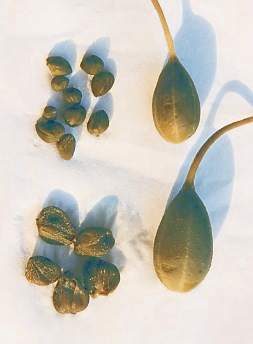Capers, Demystified
 Scientifically speaking, capers are the pea-sized, unopened flower buds of Capparis spinosa (Capparidaceae), a shrub prevalent in the Mediterranean region. Caper berries are the fruit of this same shrub. If you’ve never seen them, this picture is to-scale and shows their actual size.
Scientifically speaking, capers are the pea-sized, unopened flower buds of Capparis spinosa (Capparidaceae), a shrub prevalent in the Mediterranean region. Caper berries are the fruit of this same shrub. If you’ve never seen them, this picture is to-scale and shows their actual size.
Let’s break it down one time… So there’s this bush, right–the caper bush. It’s a flowering bush. Capers, the tiny little green balls you find pickled in jars, and caper berries, the slightly larger, berryish-looking green things also sold–stem intact–pickled in jars, are both this bush’s flower — cultivated before the flower had a chance to bloom. Tricky, huh?
It’s really not that tricky! Capers are the bud at earliest stage of development while caper berries are the bud at a later stage of development. So if you’ve got a bud at stage one, it’s a caper. If you’ve got a bud at stage two, it’s a caper berry. If you let that bud grow even more you would have a caper flower. Get it?
Good. Want to read more? Check out this article. Insider’s Tip: Use deep-fried capers as a canape garnish. Capers are delicious when deep-fried. They open up into beautiful little flowers that impart loads of flavorful salty goodness (thanks to their pickling process and their close relation to the cabbage/mustard family–Brassicaceae).
P.S. (Who knew that cabbage and mustard were in the same family?!)



 It’s so hard to find really good hot chocolate these days. My ultimate hot chocolate is made with very dark chocolate–a 70% couvature would be lovely–it’s nice and warm, but not hot enough to burn my tongue and not so hot that I have to wait for fifteen minutes before it’s safe to drink. It’s smooth, frothy, flavorful and satisfying; obviously not a hot chocolate made with powder. Just the thought of those little packets with rock hard mini-mallows makes my teeth feel gritty. If you’ve got a craving for the real stuff, try this thick, rich, creamy recipe–especially nice served with a crisp little cookie:
It’s so hard to find really good hot chocolate these days. My ultimate hot chocolate is made with very dark chocolate–a 70% couvature would be lovely–it’s nice and warm, but not hot enough to burn my tongue and not so hot that I have to wait for fifteen minutes before it’s safe to drink. It’s smooth, frothy, flavorful and satisfying; obviously not a hot chocolate made with powder. Just the thought of those little packets with rock hard mini-mallows makes my teeth feel gritty. If you’ve got a craving for the real stuff, try this thick, rich, creamy recipe–especially nice served with a crisp little cookie: Have you seen goat milk yogurt in your favorite grocery store lately? Chances are you haven’t– unless you live in Northern California or some other very health-conscious locale. It’s goaty for sure!
Have you seen goat milk yogurt in your favorite grocery store lately? Chances are you haven’t– unless you live in Northern California or some other very health-conscious locale. It’s goaty for sure!